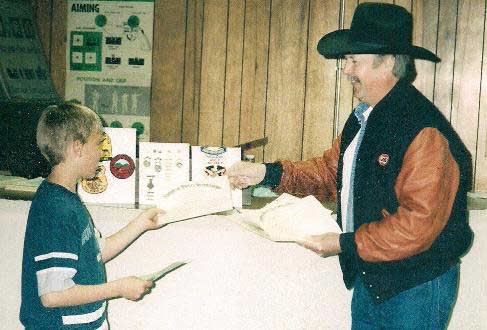 |
|
Lyle Eckman |
Lyle Eckman spent the better part of 3 decades teaching marksmanship
and firearm safety to the young people of eastern Washington. I spent about 15
years working with him as a part of the NRA Junior Marksmanship Program. He
loved working with the kids and was an outstanding teacher. He was also a
lifelong shooter -- a Master class rifleman, and an Expert bullseye (handgun)
shooter. He served in the US Navy aboard the USS Enterprise in Viet Nam. He was
a gentle soul with strongly held opinions on what combat weapons should (and
should not) be. He had a definite warm spot in his heart for the M1A, the M1
Garand, and the Colt 1911. A fan of Jeff Cooper, when the 10mm cartridge came to
be, Lyle recognized that it’s combination of higher velocity, flatter
trajectory, and adequate bullet weight/diameter generated greater effective
range, making it a more effective combat weapon and extracting the most power
that could be sensibly squeezed from the 1911 platform. When Colt brought out
the 10mm in the 1911A1 platform in the Delta Elite in the late 1980s, he bought
a 5” blued model. He shot the gun a modest amount for familiarity and function,
but not a lot. Mostly, it was a “just in case” gun, an optimum tool kept in
prime condition and ready to go on a moment’s notice, with a healthy supply of
ammo on hand. Lyle always had a twinkle in his eye when he spoke of this gun; it
was clearly very special to him.
In the early 90s, Thompson-Center Association had a run of 10” TC
barrels chambered for the 10mm made available to members. These carried very
friendly price tags and I bought one for a re-chambering project (.40-50 Sharps
Straight). Knowing his fondness for the 10mm, I told Lyle about this and he lit
up like a Christmas tree, so I bought a second one and gave it to him as a gift.
Lyle died in October 2010 after a long, tough-willed fight with
cancer. As we were going through his guns I found the 10mm TC barrel, still in
the box. The Colt Delta Elite was clean and oiled and ready to rock-n-roll
(complete with 2 spare magazines). Remembering his fondness for the 10mm, I
decided to give these two a home in an effort to keep a portion of my friend’s
legacy alive and to preserve that “twinkle”.
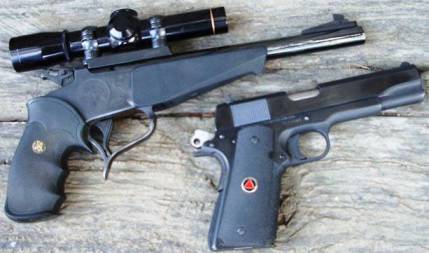 |
|
10mm T/C Contender & Colt
Delta Elite |
I have worked with the 10mm cartridge a little bit before in the S&W
610 platform, and have a good feel for what it is capable of. While not
necessarily an ideal handgun hunting cartridge, when properly loaded it is
capable of performing admirably on small and medium game. My goal was to develop
a good cast HP load for the 10mm that would be an effective hunting load. I
wanted to get as much bullet mass as possible that would still allow me to get
velocities 1100+ fps to insure positive HP expansion. I looked through my mould
box and found a 2-cavity RCBS 10MM-200-SWC mould that I knew from previous
experience cast a good bullet that shot well in the S&W 610 10mm. Generally
speaking, it is possible to push 200 grain bullets as much as 1200 fps (or more)
from the 10mm, so I figured that 1100 fps or so would give me what I was looking
for -- good power, good expansion and not beat up the Colt over time. I packaged
the RCBS mould up and sent it off to Erik Ohlen of
Hollow Point Bullet Mold Service;
erik@hollowpointmold.com; (541) 738-2479), with instructions to
perform his “inset bar conversion” to make a 2-cavity HP mould, with .110”
cavities that were .325” deep, with a 7 degree taper and rounded HP pin tips.
The mould was returned a couple of weeks later with the Ohlen 2-cavity HP
conversion exactly as I had requested. Erik sure does beautiful work!
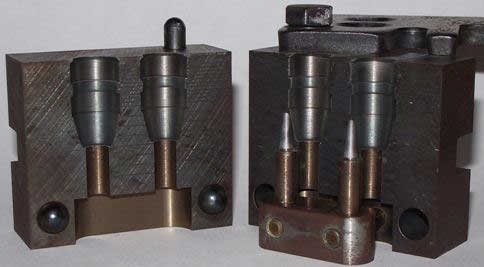 |
|
RCBS 10MM-200-SWC mould converted to Eckman
HP. |
I mounted the mould onto a pair of handles and fired up the lead pot.
The mould cast very nicely, and created quite a pile of bullets in no time! I
didn’t actually time myself this particular casting session, but with similar
2-cavity HP moulds I have no problem casting 5-6 HP’s a minute, and this mould
felt like it was casting at the same cadence as those other moulds. These
bullets were cast with recovered range scrap (BHN measured at 9-10), and they
dropped from the blocks weighing 204 grains and .402” diameter. Lyle really
liked the 10mm cartridge, and he would have really liked this bullet in the
10mm, so it only seems appropriate to name this design in his memory -- this is
the “Eckman hollow point”.
For lighter bullets in the 10mm I generally like to use AA #7 and
HS-7, but for 200 grain bullets I have generally gotten superior results using
AA #9 and so I tend to gravitate to that powder first when dealing with a new
bullet in that weight range. Test loads were tried with HS-6, HS-7, AA #7 and AA
#9, and sure enough, the best accuracy was obtained with AA #9. Also learned in
these tests was that better groups and more uniform velocities were obtained
using the CCI 350 primer instead of a standard large pistol primer.
The load I finally settled on for the Eckman HP was 11.5 grains of
AA #9, sparked with a CCI 350 Large Pistol Magnum primer, seated to an overall
length of 1.25”, and taper crimped.
Thus assembled, this lightly compressed load shoots well and
feeds reliably in the Delta Elite. This load also shoots well in the 10”
Contender and the S&W 610’s that I’ve shot it in (for the S&W 610 and the Delta
Elite, this load shot better when the Eckman HP was sized .400”; the T/C
Contender preferred it to be sized .401”). This load should be running in the
1100-1150 fps range, depending on barrel length.
 |
|
10mm loaded rounds & and as
cast Eckman HP. |
Lyle was all about teaching firearm safety and marksmanship to the
next generation so they could enjoy the shooting sports safely and responsibly,
so it just seemed appropriate to have the first animal taken with the Eckman HP
be shot by a member of the younger generation (and one of our former junior
shooters). I have known John since he was 4 years old (over 20 years) and have
enjoyed hunting with him for the past several years. John has taken several
other hogs in recent years, but this would be his first time to hunt hogs with a
handgun. I wanted him to start out with a revolver that was known to be
accurate, and one that wouldn’t generate any bad habits with excessive recoil
and muzzle blast, but would have adequate power to drop a medium-sized meat hog
quickly and humanely. The N-framed full-lug S&W 610 chambered in 10mm seemed
like a sensible choice, and John’s eyes lit up at the idea of being the first
person to take an animal using the Eckman HP.
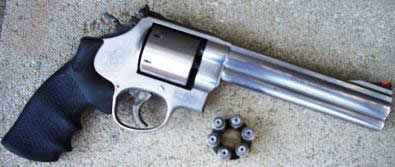 |
|
S&W Model 610 10mm, full moon
clip, Eckman HP's. |
Also along for this trip was my long-time hunting partner Kyle, down
from Spokane. Kyle has always wanted to shoot a pig, but had never gotten
around to doing it. He’s had a really nice Ruger Redhawk .41 Magnum (fitted with
a 2x Burris) for years that he just dotes on, and he decided that this sounded
like a good opportunity to make some pork with his pet .41.
We got settled in to the ranch uneventfully. After a big breakfast the
next morning, we got out and found hogs fairly soon. The moon had been out much
of the night and they had been feeding in the moonlight, so they were sleeping
in, all bunched together, making it difficult for us to get a good look at
individuals to pick ones of the size we were looking for. We tried several
methods to rouse them (including shouting at them), but had no luck. These hogs
were pretty tame and they wanted their beauty sleep.
We left to go find a black Hawaiian ram for me. We went all over the
ranch looking for a black Hawaiian, including several of the known ram hang-outs
-- the big pasture on top, the rocky canyon, the sheep shack, the saddle, etc.
-- but never saw any sign of a black Hawaiian. There were supposed to be a
couple good black Hawaiian rams on the ranch, but we never saw them. It appeared
that the inventory of animals was way down. The larger pastures were showing
little sign of being grazed (a first in my experience), so we came back down the
hill for lunch, and to re-group for the afternoon hunt.
After lunch, we found that the hogs were up and moving about. We were
quickly able to identify two good meat hogs for Kyle and John. Kyle, having
never shot a hog before, was given first shot. He was using Remington factory
210 grain SP ammunition in his Ruger Redhawk .41 Magnum. He placed his shot
beautifully -- raking both lungs and perfectly center-punching the heart. The
Remington 210 grain SP exited the 300 lb sow. She staggered about 15 feet and
fell on her side, with a finger-thick stream of blood squirting 6 feet out of
the entry hole. The sow was dead in seconds.
 |
|
Kyle & meat hog taken w/41 Mag. |
The rest of the herd immediately got excited and scrambled up the hill
to lick up some of the fresh blood (as hogs are wont to do). The 300 lb boar
that John had picked out stayed clustered up in the herd and just would not give
a good shot presentation. Then he wandered down to the water hole/mud wallow and
took a bath. During this performance, he scratched himself all over using the
bank (he was at this for quite a while, so he must have been pretty itchy). John
didn’t want to have to drag him out of that mud wallow, so we sat back and
waited for the boar to address all of his itchy spots, and then move up onto the
bank to find a spot in the shade. He was most uncooperative about giving a
decent shot presentation. Suddenly he stepped out to the side of the herd and
turned, giving a clear 20 yard shot and quartering away slightly. John quickly
brought the S&W 610 up, drew a bead just behind the right shoulder, about 6” up
and fired. I saw the bullet hit, and as the boar scrambled away listing heavily
to port, I could see spray emanating from the entrance wound. The boar made it
all of about 10 feet and collapsed……. right into the middle of the creek! The
Eckman HP had gone just above the heart and had expanded well, shredding both of
the lungs, and punched its way into farside (left) shoulder. The black boar died
very quickly (and very wet!).
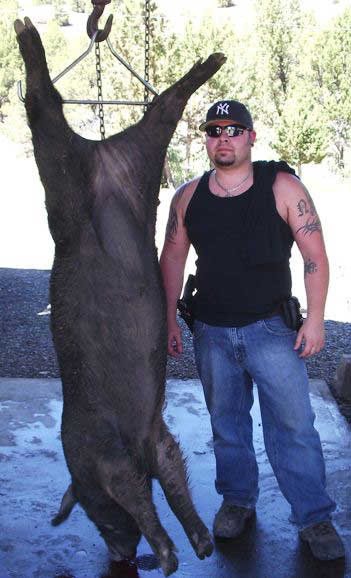 |
|
John & hog taken w/10mm
Eckman HP. |
We had two firsts in a matter of minutes of one another -- Kyle had
his first hog and John had his first handgun kill, and both had been
picture-perfect, clean, one-shot kills. We got the two hogs loaded onto Loren’s
4-wheeler trailer, and then we went down to the skinning shed to get them hung
up.
As the hogs were getting skinned, I was pondering my options.
Eventually, I decided to take a Dahl ram, and settled on an old desert tan Dahl
that I had seen earlier in the day. I found him with another ram and 5 or 6
Corsican lambs on a partially wooded hillside, about a quarter of a mile from
where I had last seen him. I was able to get fairly close, but they all stayed
bunched up, even when they were moving, and getting a good clean shot
presentation was impossible. Eventually, the desert tan Dahl ram stepped out to
the right of the group, quartering strongly away from me (about 45 degrees,
facing my right), at a little over 30 yards and I put the crosshairs on the
right rear ribcage, intending to rake the lungs and break the farside (left)
shoulder. The 10mm TC put the Eckman HP right where I told it to go, but the ram
just trotted off away from me, showing no signs of being hurt. Reviewing the
shot, I felt good about the bullet placement, but I was a bit confused about him
not going down. I chased him for a couple of minutes, but wasn’t able to get a
clear shot (they were staying all bunched up and weaving in and out of the
junipers). A couple of times I could make out the entry wound so I knew that
bullet went where I had wanted it to go, but he was still on his feet, his head
was still up and he was keeping up with the others in his group. Eventually I
was able to swing around in front of the group and turn them uphill, and as they
swung around above me, I was able to get a clear 20 yard shot on the ram. Once
again, this was a quartering away shot from the right, but this time at a much
shallower angle (maybe 20-25 degrees). Once again the TC put the 200 grain
Eckman HP right where I wanted it to go. This time the ram scrambled off across
the slope, with his head hung low and his left front foot dragging. He piled up
after about 20 feet, and started rolling slowly down the hill. Closer inspection
revealed that the first shot had hit the next to the last rib on the right side
and turned 90 degrees to the left, going through the paunch and exiting in the
middle of the belly (the exit got plugged with browse and didn‘t bleed at all).
A freak occurrence to be sure, but sometimes bullets do strange things. The
finisher had entered in the middle of the right side ribcage, expanded very
nicely indeed, shredded both lungs, and exited through the left shoulder. We
took some pictures and then dragged the ram down the hill to the truck and got
him back to the skinning shed. The afternoon was heating up and that cold beer
back at the skinning shed sure tasted good!
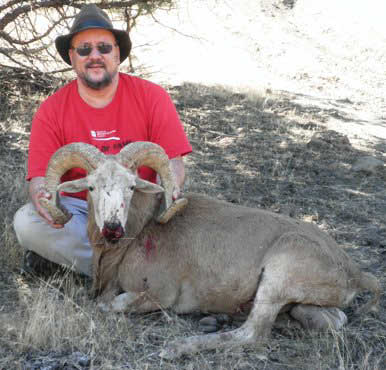 |
|
Glen & the Desert Dahl ram. |
That evening I gave John a little memento to commemorate his first
handgun hunt, then we had grilled steaks with sautéed mushrooms and 4-bean
salad, and sat around the campfire telling hunting stories until late. Sleep
came easily that night!
The 200 grain .40 caliber Eckman HP is probably a little on the light
side for 300 lb hogs (I generally prefer to have hunting bullets exit, if
possible), but it managed to make short work of one as a result of John’s superb
shot placement. When I originally envisioned this design, my thinking was aimed
more at critters in the 100-250 lb class (deer and antelope and such), and since
the 10mm was originally envisioned as a combat round by Col. Jeff Cooper, I
think the Eckman HP falls into the good Colonel’s vision quite nicely. While the
first shot on the desert Dahl ram behaved oddly, I think that was just a fluke
(I have had jacketed bullets turn in similar fashion before), and not due to the
bullet design. Certainly, the finisher behaved exactly as expected, expanding
beautifully and punching out through the far shoulder after penetrating about
20”. Excellent performance from the 10mm Auto cartridge. I think Lyle would
approve.
|